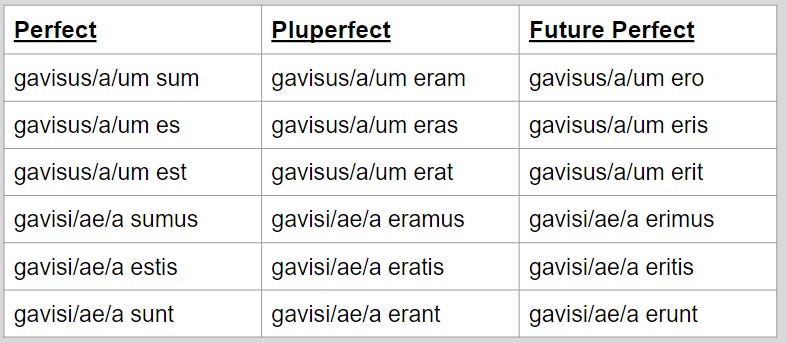Semi-Deponents: The Sneakiest Latin Verbs
January Latin Challenge: Day 23 of 31
Semi-deponents can be a pain because they’re just so sneaky! But there aren’t many, and once you know them, they’re super easy to translate.
Hi everyone, and welcome back to bambasbat for Day 23 of the January Latin Challenge! This is a super quick rundown of semi-deponent verbs. The reason I am being so lame and calling them sneaky is because, just like deponent verbs, these are verbs that look passive in form, but are actually active in meaning. They use passive endings but are translated as active verbs.
However, the key difference is that semi-deponents are only passive in form SOME of the time.
They use passive endings for some tenses, which is what we will look at now.
If you can’t remember the passive endings, go and download my Complete Verbs Reference Guide - it’s got all tenses, voices and moods, so will be really useful when looking at these active verbs that disguise themselves as passives. If you missed yesterday’s post about passive verbs, you can find it here in the bambasbat archive.
Semi-Deponents
Let’s look at gaudeo. It is one of the most common semi-deponent verbs so you are likely to run across it at some point.
gaudeo, gaudere, gavisus sum - to rejoice or to be glad
As you can see an active 1st person present form: gaudeo - I rejoice/I am glad.
It also has an active form of the present infinitive - gaudere. This tells me that the present, imperfect, and future tenses of gaudeo are all active in form. This is really helpful!
The perfect stem however is passive in form - gavisus sum. This is using the perfect passive participle and the verb to be in the present tense - the way perfect passive verbs are always formed.
Remember: this is still an ACTIVE verb, it is just disguised as a passive.
Think of it as putting on a façade, like a waiter with a customer service face, or a voice teachers use to talk to parents. The real active verb is still there underneath, but it is pretending to be passive.
How does this help me?
So semi-deponents are passive in the perfect tense, as we have seen from the principal parts. The perfect tense in the passive is formed with the perfect passive participle and the present tense of the verb “to be”.
Remember that the verb to be has to match the person doing the verb, so if it is “I” it uses sum, “you” uses es, “he/she/it” uses est, and so on. And as an addition, the participle part, the gavisus, has to match the number and gender of the person or thing doing the verb. It will always be in the nominative, as the person who is the subject of the verb will be the nominative.
So for the perfect, we get gavisus/a/um sum - even though it is active in meaning - I rejoiced..
Perfect semi-deponents
For the pluperfect we still use that perfect stem - so this tense also looks passive. The pluperfect is formed with the verb “to be” in the imperfect this time.
The middle column above is translated, in order, as “I had rejoiced”, “you had rejoiced”, “he/she/it had rejoiced”, “we had rejoiced”, “you plural had rejoiced”, and “they had rejoiced”.
Future Perfect semi-deponents
The future perfect is also passive in form but active in meaning. Again look at the table above: take the perfect stem, that participle: gavisus/a/um. Add the verb “to be” onto the end - this time the future tense.
The right hand column above means “I will have rejoiced”, “You will have rejoiced”, “he/she/it will have rejoiced”, and so on.
Keep the active meaning, but the form is like a passive.
Here are some other semi-deponent verbs:
audeo, audere, ausus sum - to dare
fido, fidere, fisus sum - to trust
confido, confidere, confisus sum - to confide in, to rely on, to trust
diffido, diffidere, diffisus sum - to distrust, to despair
gaudeo, gaudere, gavisus sum - to rejoice, to be glad
soleo, solere, solitus sum - to be accustomed, to be in the habit of
The most common, like gaudeo, are audeo and soleo.
Luckily there aren’t very many even when you get to A level, so don’t stress too much about them. Just recognise these ones and be aware that you might see them in the passive voice but you should translate them in the active voice.
And that’s all there is to semi-deponent verbs! I hope you have found this post useful, let me know what you think or if you have any questions in the comments. Thanks for reading, and I’ll see you tomorrow on bambasbat for Day 24 of the January Latin Challenge!


